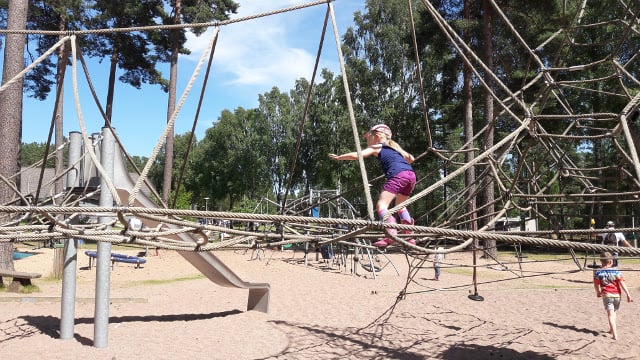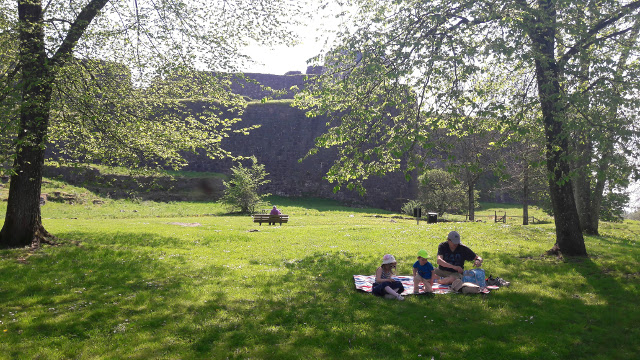There was a time when I thought that the incredibly diverse and enriching range of cultural, historical, intellectual, and physical experiences my parents provided me as a child had set the bar quite high. Perhaps so high that I would struggle as a parent to reach it. I also worried the traditionally non-kid-friendly cultural and historical activities my husband and I enjoyed so much would be off-limits to us until our children were older.
That was before we moved to Sweden.
It's not just that there is an incredible variety of kid-centered activities in this country. It's that places where kids would typically be bored to tears or where other adults might want to strangle parents who bring children are incredibly kid-friendly. I'm talking about art museums, outdoor museums, nature reserves, historical sites like castles, palaces and churches, and even coffee shops.
Although I freely admit that we are the kind of parents who would probably take our kids to these places anyway, it is a blessing for ourselves and everyone else that they almost always have something to keep the children occupied and happy. When we're not stressed about keeping our children on their best behavior, we can also relax and enjoy ourselves. People around us may not realize it, but this fleeting state of family harmony benefits them, too (something they would discover if it suddenly went the opposite way). Everyone wins!
Our slightly obsessive interest in visiting as many of the plethora of historic churches in Småland, for instance, has been facilitated by the fact that they all have a kids’ play area and/or are located next to or nearby a playground. Afterwards, we can stop for fika at a coffee shop while the kids entertain themselves in what is often a well-appointed play area. Meanwhile, nobody bats an eyelash.
As we were planning our summer holiday activities, we had read about places being kid-friendly. In all cases, what we encountered went far beyond our expectations. They were so kid-friendly, in fact, that I don’t know who was more excited – the kids or my husband and me. From mock sword-fighting and jousting in a castle courtyard to wardrobes full of historical costumes to wear at will. Where were these activities when I was growing up?
Even the hotels we stayed in had play areas for the kids, usually placed conveniently close to sofas for the adults to relax and enjoy a drink from the hotel bar. When I was a kid and my parents wanted to enjoy a drink, I had to nurse a Shirley Temple kids' cocktail and remain on my best behavior while amusing myself with nothing more than a miniature paper umbrella and an orange rind.
Any fears I might have had that the fun would end with the summer was eliminated when we made our first trip as a family to a Swedish art museum. Entering through the gift shop, I found myself in the unusual situation of being able to leisurely browse the books while my husband oversaw our children as they played with the toys and puzzles set out for that purpose. And guess what? We never had to worry about the children playing with things they weren't supposed to be playing with.

A pint-sized suit of armour at a Swedish castle. Photo: Victoria Martinez
Inside the museum itself, we were all able to play. Old telephones, typewriters and games kept us all busy – the children figuring out what on earth these strange devices were, and my husband and I reliving our own childhoods. It wasn't until we entered an exhibit of fine art that I even had to loud-whisper the phrase echoed down through generations of parents: “NO TOUCHING”, But then at the end of each exhibit was a play area for the kids. This rotation served us well for an entire afternoon and we all left feeling satisfied and happy.
Have I mentioned the playgrounds in Sweden? I realized recently that our 3-year-old son says, “That's awesome!” a lot. I suspect it's because of all the times I have said just that when we've discovered a new playground. And there really are some truly awesome playgrounds in Sweden. So awesome, in fact, that whenever decently possible, I take up my kids' invitations of, “Come on, Mommy. You try it!”. Don't mind if I do.

An impressive playground in Sweden. Photo: Victoria Martinez
These are not the rusty metal jungle gyms slapped onto concrete or hard dirt surfaces that populated my childhood. They are not even the undoubtedly cool plasticized modern chutes and ladders-type you can find so easily everywhere. I'm talking about full obstacle courses, seriously long tube slides, miniature villages, pedal car racecourses, and trampolines of every size, shape and bounciness level, just to name a few. If I didn't already have children, I think I would readily offer to babysit some just so I could have a reason to go to playgrounds like these.
I only have one worry. How are my children going to top this with their kids one day?
Victoria Martínez is an American historical researcher, writer and author of three historical non-fiction books. She lives in Småland county, Sweden, with her Spanish husband and their two children.
Read more from her family column on The Local here.



 Please whitelist us to continue reading.
Please whitelist us to continue reading.